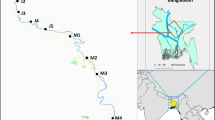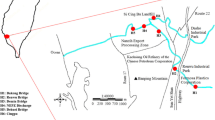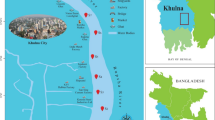Abstract
The release of a large quantity of heavy metals into the Dhaleswari River from the tannery, dyeing, and other industrial setups and their subsequent transfer to food chains through fish consumption have been an alarming issue in Bangladesh. To study the pollution level, a total of seven fish species, namely Heteropneustes fossillis, Channa punctata, Nandus nandus, Chanda nama, Anabas testudineus, Mystus gulio, and Colisa fasciata, were collected in winter from the Dhaleswari River and the total concentrations of Cr, Pb, Ni, and Zn in head and body tissues were analyzed separately. The concentrations of Cr, Pb, and Zn were found 300, 20, and 10 times higher, respectively, than the guideline value of the Food and Agriculture Organization (FAO)/World Health Organization (WHO), indicating possible health risks to humans. In most cases, bioaccumulation factors (BAFs) exceeded the highest limit, expressing that most of the species, especially C. nama, A. testudineus, and C. fasciata, were in the highly bioaccumulative state. The health risks associated with fish consumption were determined in terms of estimated daily intake (EDI), non-carcinogenic risks (THQ), and carcinogenic risk (TR) factors. The THQs for Cr and Pb crossed the maximum value of 1 in all the fish species except Pb in Mystus gulio, which might cause different non-carcinogenic diseases upon consumption of these fishes. In all the fish species, the carcinogenic risk factor for Cr exceeded the standard value (10−4), indicating chronic cancer risk to humans. Although the estimated daily intake (EDI) values did not cross the permissible limit, continuous consumption of contaminated fish from the target area may cause serious health complications. This study revealed that consumption of these fishes exposed people to a higher risk of non-carcinogenic and carcinogenic consequences in terms of human health.





Similar content being viewed by others
Data Availability
Not applicable
References
Ali MM, Ali ML, Proshad R, Islam S, Rahman Z, Kormoker T (2020) Assessment of trace elements in the demersal fishes of a coastal river in Bangladesh: a public health concern. Thalassas 36:641–655. https://doi.org/10.1007/s41208-020-00227-7
Ashraf MA, Hussain I, Rasheed R, Iqbal M, Riaz M, Arif MS (2017) Advances in microbe-assisted reclamation of heavy metal contaminated soils over the last decade: a review. J Environ Manag 198:132–143. https://doi.org/10.1016/j.jenvman.2017.04.060
Kumari B, Kumar V, Sinha AK, Ahsan J, Ghosh AK, Wang H, DeBoeck G (2017) Toxicology of arsenic in fish and aquatic systems. Environ Chem Lett 15(1):43–64. https://doi.org/10.1007/s10311-016-0588-9
Tilzer MM, Khondker M (1993) Hypertrophic and polluted freshwater ecosystems: ecological bases for water resource management: Proceedings of an International Symposium on Limnology held in Dhake, Bangladesh, 25–28 November, 1991. University of Dhaka, Department of Botany
Saha PK, Hossain MD (2011) “Assessment of heavy metal contamination and sediment quality in the Buriganga River, Bangladesh.” In Proceeding: 2nd International Conference on Environmental Science and Technology. IPCBEE, Singapore, vol. 6, pp. 384–388
Kulkarni R, Deobagkar D, Zinjarde S (2018) Metals in mangrove ecosystem and associated biota: a global perspective. Ecotoxicol Environ Saf 153:215–228. https://doi.org/10.1016/j.ecoenv.2018.02.021
Shariati S, Pourbabaee AA, Alikhani HA, Rezaei KA (2019) Investigation of heavy metal contamination in the surface sediments of Anjali wetland in North of Iran. Pollution 5(1):211–224. https://doi.org/10.22059/poll.2018.257276.438
Hossain MA, Uddin MK, Molla AH, Afrad MS, Rahman MM, Rahman GK (2010) Impact of industrial effluents discharges on degradation of natural resources and threat to food security. Agriculturists 8(2):80–87. https://doi.org/10.3329/agric.v8i2.7581
Uddin MJ, Parveen Z, Hossain MF (2016) Status of heavy metals in water and sediments of canals and rivers around the Dhaka city of Bangladesh and their subsequent transfer to crops. Adv Plants Agric Res 5(4):593–601
Ahmed MK, Ahamed S, Rahman S, Haque MR, Islam MM (2009) Heavy metals concentration in water, sediments and their bioaccumulation in some freshwater fishes and mussel in Dhaleshwari River, Bangladesh. Terr Aquat Environ Toxicol 3:33–41. https://doi.org/10.22059/ijer.2010.24
Fabiani C, Ruscio F, Spadoni M, Pizzichini M (1997) Chromium (III) salts recovery process from tannery wastewaters. Desalination 108(1–3):183–191
Imamul Huq SM (1998). Critical Environmental Issues Relating to Tanning Industries in Bangladesh in: Naidu et al., (eds). Towards Better Manager of Soils Contaminated with Tannery Waste. Proceedings of a Workshop held at the Tamil Naidu Agricultural University, Coimbatore, India 31st January to 4th February, 1998). pp 22-28.
Hajeb P, Jinap S, Ismail A, Fatimah AB, Jamilah B, Rahim MA (2009) Assessment of mercury level in commonly consumed marine fishes in Malaysia. Food Control 20:79–84. https://doi.org/10.1016/j.foodcont.2008.02.012
Ahmed MK, Baki MA, Islam MS, Kundu GK, Habibullah-Al-Mamun M, Sarkar SK, Hossain MM (2015) Human health risk assessment of heavy metals in tropical fish and shellfish collected from the river Buriganga Bangladesh. Environ Sci Pollut Res Int 22(20):15880–15890. https://doi.org/10.1186/s40064-016-3357-0
Proshad R, Islam MS, Kormoker T, Masud EM, Ali MM (2018) Assessment of toxic metals contamination with ecological risk of surface water and sediment of Korotoa River in Bangladesh. Int J Adv Geosci 6:214–221. https://doi.org/10.14419/ijag.v6i2.13742
Singh H, Pandey R, Singh SK, Shukla DN (2017) Assessment of heavy metal contamination in the sediment of the River Ghaghara, a major tributary of the River Ganga in Northern India. Appl Water Sci 7:4133–4149. https://doi.org/10.1007/s13201-017-0572-y
Habibullah-Al-Mamun M, Ahmed MK, Raknuzzaman M, Islam MS, Ali MM, Tokumura M, Masunaga S (2017) Occurrence and assessment of perfluoroalkyl acids (PFAAs) in commonly consumed seafood from the coastal area of Bangladesh. Mar Pollut Bull 124:775–785. https://doi.org/10.1016/j.marpolbul.2017.02.053
Rahman MS, Islam MR (2009) Adsorption of Cd (II) ions from synthetic waste water using maple sawdust. Energy Sources Part A Recover Util Environ Eff 32:222–231. https://doi.org/10.1080/15567030802459297
Lee K, Kweon H, Yeo J, Woo S, Han S, Kim JH (2011) Characterization of tyrosine-rich Antheraea pernyi silk fibroin hydrolysate. Int J Biol Macromol 48:223–226. https://doi.org/10.1016/j.ijbiomac.2010.09.020
Fang Y, Sun X, Yang W, Ma N, Xin Z, Fu J, Liu X, LiuM MAM, Zhu X (2014) Concentrations and health risks of lead, cadmium, arsenic, and mercury in rice and edible mushrooms in China. Food Chem 147:147–151. https://doi.org/10.1016/j.foodchem.2013.09.116
Tsai HS (2014) Environment health check needed. Taipei Times, Oct 31, 2014. Taipei, Taiwan. http://www.taipeitimes.com/News/editorials/archives/2014/10/31/2003603303 Accessed 1 March 2021
Raknuzzaman M, Ahmed MK, Islam MS, Al-Mamun MH, Tokumura M, Sekine M, Masunaga S (2016) Trace metal contamination in commercial fish and crustaceans collected from coastal area of Bangladesh and health risk assessment. Environ Sci Pollut Res 23:17298–17310. https://doi.org/10.1007/s11356-016-6918-4
Clesceri LS, Greenberg AE, Eaton AD (1998) Standard methods for the examination of water and wastewater, 20th edn. DC, American Public Health Association, Washington
American Public Health Association (APHA) (2012) Standard methods for the examination of water and wastewater. American Public Health Association, American Water Works Association, Water Environment Federation, Washington DC
Liu CW, Lin KH, Kuo YM (2003) Application of factor analysis in the assessment of groundwater quality in a blackfoot disease area in Taiwan. Sci Total Environ 313:77–89. https://doi.org/10.1016/S0048-9697(02)00683-6
Vu CT, Lin C, Yeh G, Villanueva MC (2017) Bioaccumulation and potential sources of heavy metal contamination in fish species in Taiwan: assessment and possible human health implications. Environ Sci Pollut Res 24:19422–19434. https://doi.org/10.1007/s11356-017-9590-4
Zhong W, Zhang Y, Wu Z et al (2018) Health risk assessment of heavy metals in freshwater fish in the central and eastern North China. Ecotoxicol Environ Saf 157:343–349. https://doi.org/10.1016/j.ecoenv.2018.03.048
Qiu YW (2015) Bioaccumulation of heavy metals both in wild and mariculture food chains in Daya Bay, South China. Estuar Coast Shelf Sci 163:7–14. https://doi.org/10.1016/j.ecss.2015.05.036
Zheng N, Wang Q, Zhang X et al (2007) Population health risk due to dietary intake of heavy metals in the industrial area of Huludao City, China. Sci Total Environ 387:96–104. https://doi.org/10.1016/j.scitotenv.2007.07.044
Arnot JA, Gobas FAPC (2006) A review of bioconcentration factor (BCF) and bioaccumulation factor (BAF) assessments for organic chemicals in aquatic organisms. Environ Rev 14:257–297. https://doi.org/10.1139/A06-005
Traina A, Bono G, Bonsignore M et al (2019) Heavy metals concentrations in some commercially key species from Sicilian coasts (Mediterranean Sea): potential human health risk estimation. Ecotoxicol Environ Saf 168:466–478. https://doi.org/10.1016/j.ecoenv.2018.10.056
Batista BL, Nacano LR, de Freitas R, de Oliveira-Souza VC, Barbosa F (2012) Determination of essential (Ca, Fe, I, K, Mo) and toxic elements (Hg, Pb) in Brazilian rice grains and estimation of reference daily intake. Food Nutr Sci 3:129. https://doi.org/10.4236/fns.2012.31019
USEPA (2000) Guideline for assessing chemical contaminant data for use in fish advisories, Vol. I: Fish sampling and analysis, Third edition. Office of Water. U.S. Environmental Protection Agency, Washington, DC (Document No. EPA 823-B-00–007. November 2000)
Wei Y, Zhang J, Zhang D, Tu T, Luo L (2014) Metal concentrations in various fish organs of different fish species from Poyang Lake, China. Ecotoxicol Environ Saf 104:182–188. https://doi.org/10.1016/j.ecoenv.2014.03.001
Varol M, Kaya GK, Alp A (2017) Heavy metal and arsenic concentrations in rainbow trout (Oncorhynchus mykiss) farmed in a dam reservoir on the Firat (Euphrates) River: risk-based consumption advisories. Sci Total Environ 599:1288–1296. https://doi.org/10.1016/j.scitotenv.2017.05.052
FAO (2006) Arsenic contamination of irrigation water, soil, and crops in Bangladesh: risk implications for sustainable agriculture and food safety in Asia. Food and Agriculture Organization of the United Nations Regional Office for Asia and the Pacific, Bangkok
HIES (2011) Preliminary report on household income and expenditure survey-2010. Bangladesh Bureau of Statistics, Statistics Division. Ministry of planning, Dhaka
USEPA (2010) ‘Risk-based concentration table’, United States Environmental Protection Agency, Washington, DC, USA. http://www.Epa.Gov/reg3hwmd/risk/human/index Accessed 21 Jan 2021
USEPA (1989) Risk assessment guidance for superfund. Hum Health Eval Man (Part A) Vol. I; EPA/540/1–89/002. https://www.epa.gov/risk/risk-assessment-guidance-superfund-rags-part. Accessed January, 2021
Islam MS, Han S, Ahmed MK, Masunaga S (2014) Assessment of trace metal contamination in water and sediment of some rivers in Bangladesh. J Water Environ Technol 12:109–121. https://doi.org/10.2965/jwet.2014.109
USEPA (1999) Screening level ecological risks assessment protocol for hazardous waste combustion facilities. Appendix E: toxicity reference values, EPA530-D-99-001C August 1999 pp E1-E96
ECR. (The Environment Conservation Rules) (1997) Department of Environment, Government of the People’s Republic of Bangladesh. Poribesh Bhaban E-16, Agargaon, Shere Bangla Nagar Dhaka 1207, Bangladesh. 179–226
USEPA (2005) National recommended water quality criteria, United States Environment Protection Agency, Office of Water https://www.epa.gov/ground-water-and-drinking-water/national-primary-drinking-water-regulations Accessed 19 January 2021
Saranraj P, Sujitha D (2013) Microbial bioremediation of chromium in tannery effluent: a review. Int J Microbiol Res 4:305–320. https://doi.org/10.5829/idosi.ijmr.2013.4.3.81228
Bosnic M, Buljan J, Daniels RP (2000) Pollutants in tannery effluents. Regional program for pollution control in the tanning industry in South-East Asia S. RAS/92/120, United Nations Industrial Development organization
Fakhri Y, Bjørklund G, Bandpei AM, Chirumbolo S, Keramati H, Pouya RH, Asadi A, Amanidaz N, Sarafraz M, Sheikhmohammad A, Alipour M (2018) Concentrations of arsenic and lead in rice (Oryza sativa L.) in Iran: a systematic review and carcinogenic risk assessment. Food Chem Toxicol 113:267–277. https://doi.org/10.1016/j.fct.2018.01.018
FAO (1983) Compilation of legal limits for hazardous substances in fish and fishery products. FAO Fishery Circular No. 464. Food and Agriculture Organization, pp 5–100
Bashar K, Afroze JS, Ali MF, Rahaman A, Hosen MR, Hossain MS (2016) Relative study of heavy metal contamination in fishes of Buriganga River due to untreated tannery effluent and in fisheries from another source in Bangladesh. Int J Curr Res 8(10):40395–40403
Brishti PS, Islam MK, Sarkar S, Taskin F, Akter S, Salam MA, Nahar L, Billah MB (2018) Environmental contamination of heavy metals in fish and water samples of Shitalakkhya River, Dhaka, Bangladesh. Int J Sci Technol 6:86–91. https://doi.org/10.24940/theijst/2018/v6/i12/st1811-011
Malik N, Biswas AK, Qureshi TA et al (2010) Bioaccumulation of heavy metals in fish tissues of a freshwater lake of Bhopal. Environ Monit Assess 160:267. https://doi.org/10.1007/s10661-008-0693-8
Edward JB, Idowu EO, Oso JA, Ibidapo OR (2013) Determination of heavy metal concentration in fish samples, sediment and water from Odo-Ayo River in Ado-Ekiti, Ekiti-State, Nigeria. Int J Environ Monit Anal 1(1):27–33. https://doi.org/10.11648/j.ijema.20130101.14
Chi QQ, Zhu GW, Langdon A (2007) Bioaccumulation of heavy metals in fishes from Taihu Lake,China. J Environ Sci 19(12):1500–1504. https://doi.org/10.1016/S1001-0742(07)60244-7
Islam MS, Ahmed MK, Habibullah-Al-Mamun M, Raknuzzaman M, Ali MM, Eaton DW (2016) Health risk assessment due to heavy metal exposure from commonly consumed fish and vegetables. Environ Syst Decis 36:253–265. https://doi.org/10.1007/s10669-016-9592-7
WHO (2000) ‘WHO technical report series. Evaluation of certain food additives and contaminants. Fifty-third report of the joint FAO/WHO expert committee on food additives (JECFA)’, World Health Organization, Geneva, Switzerland. http://www.Who.Int/foodsafety/publications/jecfa-reports/en/Accessed 26 January 2021
Alipour H, Pourkhabbaz A, Hassanpour M (2015) Estimation of potential health risks for some metallic elements by consumption of fish. Water Qual Expo Health 7(2):179–185
Acknowledgements
We are thankful to the Ministry of Science and Technology, Government of Bangladesh, for supporting this MS thesis research (National Science and Technology Fellowship: 2019-2020; Merit No.: 148). Sincere appreciation goes to the Chairman, Department of Soil, Water and Environment, the University of Dhaka, for providing research facilities in the Advanced Research Laboratory.
Author information
Authors and Affiliations
Contributions
Md Wahiduzzaman and Zakia Parveen conceived and planned the experiments. Md Wahiduzzaman and Md Mahfuz Islam carried out the experiment, performed data analysis, and wrote the manuscript with inputs from other authors. Abdul Halim Farhad Sikder contributed to sample collection and manuscript preparation. This research was supervised by Zakia Parveen.
Corresponding author
Ethics declarations
Consent to Participate
The article does not contain any studies with human participants but fish samples from the Dhaleswari River were used for this study.
Consent for Publication
We declare that this manuscript is original, has not been published before, and is not being currently considered for publication elsewhere.
Competing Interests
The authors declare no competing interests.
Additional information
Publisher's Note
Springer Nature remains neutral with regard to jurisdictional claims in published maps and institutional affiliations.
Rights and permissions
About this article
Cite this article
Wahiduzzaman, M., Islam, M.M., Sikder, A.H.F. et al. Bioaccumulation and Heavy Metal Contamination in Fish Species of the Dhaleswari River of Bangladesh and Related Human Health Implications. Biol Trace Elem Res 200, 3854–3866 (2022). https://doi.org/10.1007/s12011-021-02963-0
Received:
Accepted:
Published:
Issue Date:
DOI: https://doi.org/10.1007/s12011-021-02963-0




